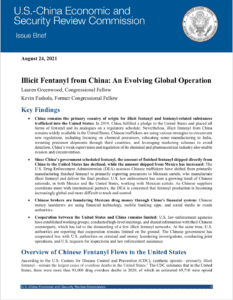The Evolving Role of Chinese Manufacturers and Criminal Gangs in the U.S. Fake Fentanyl Pill Epidemic
Established as an independent agency of the U.S. government in 2000, the United States-China Economic and Security Review Commission (USCC) provides recommendations on bilateral trade with the People’s Republic of China, evaluates security and trading risks across all industries, and conducts research on China’s actions. One of the issues examined by the USCC is the role of Chinese companies in supplying the fentanyl that has fueled the fake pill and fentanyl epidemic in the U.S.
In 2017, USCC issued its first report on the export of fentanyl, directly linking the chemicals flowing out of China to increases in overdoses, deaths, and rates of addiction in the U.S. The second report, released in 2018, found that China continued to be the primary source for fentanyl and fentanyl-like substances in the U.S. The newest report, released in August 2021, found Chinese companies adapting to a changing legal framework to maintain their prominent status as suppliers, and even venturing into money-laundering services.
Chinese manufacturers adapting to changing regulations and more aggressive law enforcement
In April 2019, China agreed to schedule all fentanyl and fentanyl analogues forcing Chinese manufacturers to pivot. There was a decline in Chinese manufacturers “willing to sell/export [finished] fentanyl products,” according to David Prince, deputy assistant director of transnational organized crime at U.S. Immigration and Customs Enforcement. Seizures of smaller but significantly purer quantities of fentanyl in the international mail dropped off in 2019.
Instead, Chinese manufacturers shifted to producing and creating additional precursor ingredients that could be synthesized into fentanyl by chemists employed directly by the drug trafficking organization (DTO) in Mexico or Canada. DTOs could then mix the fentanyl into illicit drugs or press it into counterfeit pills, which are then smuggled into the U.S., mainly across the southern border.
Additionally, Chinese manufacturers continue to evade detection by relocating some manufacturing to India, shipping precursor ingredients through third countries, and utilizing marketing schemes to avoid detection. If China were to better supervise and regulate its chemical and pharmaceutical industry, these types of maneuvers would be detected and stopped.
Chinese criminal groups begin assisting Mexican cartels with money laundering
The partnership between Chinese chemical companies and their DTOs purchasers is tight enough that they have ventured into a new service: laundering cartel money through the Chinese banking system. Illegal enterprises need to find ways to make their profits appear legitimate, and Chinese money launderers are now working with Mexican DTOs to fill this need. Drug profits flow from Mexico to China. The country’s opaque financial system obscures its origins before the money launderers return it to the Mexican DTOs, minus a cut for the launderers. For example, in November 2018, U.S. authorities arrested a Chinese national in Chicago who allegedly laundered between $25 - 65 million for one cartel. Money launderers use multiple complex techniques to hide the origins of illicit profits, including mirror transactions, virtual currencies, and the purchasing of consumer goods, which are then shipped to the DTOs.
Official cooperation between the U.S. and China begins to yield success
The USCC report noted that enforcement cooperation between the U.S. and China has improved. China scheduled all forms of fentanyl, participates in counternarcotic working groups, and complies with U.S.’s request for Advanced Electronic Data on international shipments. However, the statements of cooperation made by politicians have not always directly translated to better working relationships for federal agents on the ground, especially in enforcement and criminal prosecution. In 2020, a report by the State Department said that “China has not cooperated sufficiently on financial investigations and does not provide adequate responses to requests for financial investigation information.” Despite both the U.S. and China being signatories on a mutual legal assistance treaty, the State Department pointed out that “Many outstanding requests by both the United States and China remain unfulfilled,” further hindering U.S.-China cooperation efforts.
U.S. law enforcement has forced the Chinese criminal and chemical industry to adapt. The Chinese chemical industry remains a potent force in the creation of fentanyl that finds its way into the U.S. and kills Americans and eliminating this line of business will take additional years of work from both law enforcement, regulators, and diplomats before we see a change.
